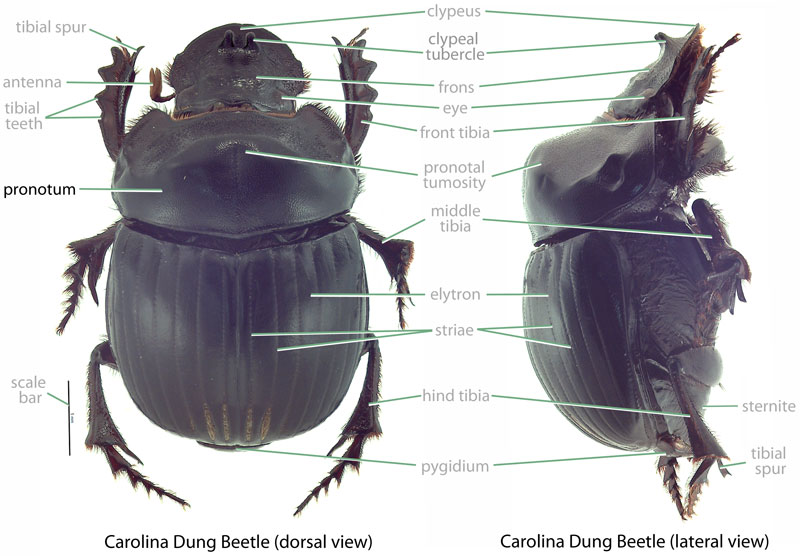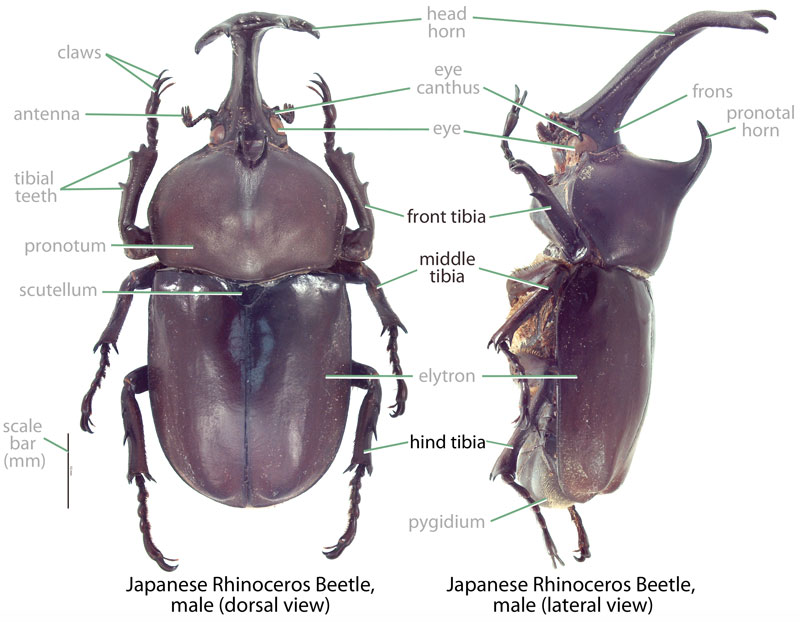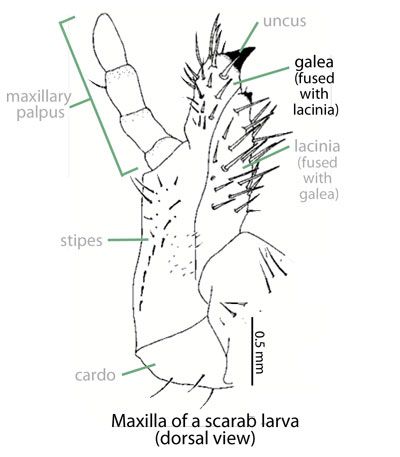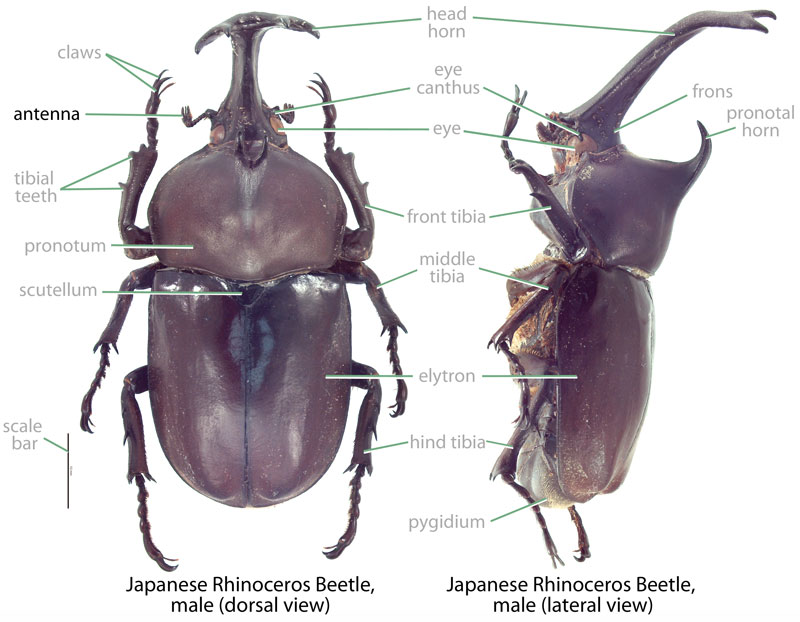Beneficial
small black and brown dung beetle
Family: Scarabaeidae Subfamily: Scarabaeinae Genus: Onthophagus Species: Onthophagus nuchicornis (Linnaeus, 1758)
DNA barcode available: specimen information
Total body length 6.7–9.5 mm (0.26–0.37 in). Body shape oval; may be caked in dung. Color black; elytraelytra:
the hardened and chitinous wing-cover of a beetle that protect and overlie the flight wing
brown, mottled with black. Small-sized dung beetle, 6-10 mm. Clypealclypeal:
of, or referring to, the clypeus
apexapex:
point or edge furthest from the body
weakly sinuatesinuate:
gently curved (specifically of margins or edges); often in reference to the clypeus
; not strongly produced or reflexedreflexed:
margin that curves upward
in either sex. Head of major male with single spine-like horn; minor male horn greatly reduced; female with transversetransverse:
extending horizontally across a surface
ridge at base of head. Ocular canthuscanthus:
a process extending over and sometimes dividing the eye
completely dividing eye. Pronotumpronotum:
the dorsal surface of the thorax
 with anterioranterior:
with anterioranterior:
the front or forward; opposite of posterior
angles rounded. Pronotumpronotum:
the dorsal surface of the thorax
 of major male with slight hump-like process; process reduced in minor male; female with rounded peg-like process. Front tibiatibia:
of major male with slight hump-like process; process reduced in minor male; female with rounded peg-like process. Front tibiatibia:
a segment of the leg articulated with the tarsus and femur
 of male somewhat slender, female tibiatibia:
of male somewhat slender, female tibiatibia:
a segment of the leg articulated with the tarsus and femur
 comparatively more stout. Scutellumscutellum:
comparatively more stout. Scutellumscutellum:
the triangular portion of the thorax between the bases of the elytra
 absent.
absent.
Undescribed in English (see Perris, 1877): For Onthophagus spp. (Ritcher, 1966Ritcher, 1966:
Ritcher P. 1966. White grubs and their allies: a study of North American scarabaeoid larvae. Oregon State University Monographs, Studies in Entomology 4: 1-219.): Grub C-shaped, hump-backed, cylindrical, and cream-colored. Maxillamaxilla:
set of paired mouthparts located posterior to the mandibles
with galeagalea:
outer branch or lobe of the maxilla
 and lacinialacinia:
and lacinialacinia:
inner portion of the maxilla distinctly separate. Epipharynxepipharynx:
distinctly separate. Epipharynxepipharynx:
lobe on the interior surface of the labrum or clypeus
with tormaetormae:
in scarab larvae, sclerotized structures on the ends of the clypeolateral suture extending towards the mesal line
united mesallymesally:
at or near midline of body
, anterioranterior:
the front or forward; opposite of posterior
phoba present. AntennaeAntennae:
paired sensory organ on head, formed from numerous segments
 4-segmented, distaldistal:
4-segmented, distaldistal:
situated away from the point of articulation, thus usually furthest from the body
segment much reduced. Legs 2-segmented. Prothoracic shieldprothoracic shield:
the chitinous plate behind the head of larvae
 without anteriorly projecting processes. Third abdominal segment bearing a prominent conical, dorsaldorsal:
without anteriorly projecting processes. Third abdominal segment bearing a prominent conical, dorsaldorsal:
of or relating to the upper surface; opposite of ventral
gibbosity covered with numerous short, stout setaesetae:
small, hair-like structure
.
Temperate Eurasia. This species is native to a broad area of temperate Eurasia, occurring from Europe and Turkey eastward to Siberia and Mongolia (Global Biodiversity Information Facility, 2015Global Biodiversity Information Facility, 2015:
Anonymous. 2015. Distributions for Onthophagus nuchicornis . GBIF.org. Available from http://www.gbif.org/species/1091565/distributions (accessed 5 May 2015).). This species was also introduced to North America in the 1840's and occurs coast to coast, from southern Canada south to Missouri (MacRae and Penn, 2001MacRae and Penn, 2001:
MacRae T and Penn S. 2001. Additional records of adventive Onthophagus Latreille (Coleoptera: Scarabaeidae) in North America. The Coleopterists Bulletin, 55: 49-50. full text (accessed, 2015)).
None. This species feeds on dung as both an adult and larvalarva:
the immature form of an insect; in scarabs, also called grub or white grub; preceded by the egg stage, followed by the pupal stage
 . There are no records of this beetle feeding on live plant tissues.
. There are no records of this beetle feeding on live plant tissues.
Adults of this species have been recorded on cattle and horse dung (Howden and Cartwright, 1963Howden and Cartwright, 1963:
Howden H and Cartwright O. 1963. Scarab beetles of the genus Onthophagus Latreille north of Mexico. Proceedings of the United States National Museum 114: 1-135.). Like many related Onthophagus species, O. nuchicornis is a dung tunneler (MacQueen and Beirne, 1975MacQueen and Beirne, 1975:
MacQueen A and Beirne B. 1975. Dung burial activity and fly control potential of Onthophagus nuchicornis (Coleoptera: Scarabaeinae) in British Columbia. Canadian Journal of Plant Science 55: 961-967. DOI: 10.4141/cjps75-152), creating a burrow near or under a fecal source. The burrow is then provisioned with feces in the form of brood balls. An egg is deposited in each brood ball, within which larval development occurs.
None. This species recycles dung and is beneficial for ranching and farming in Hawaii. Primarily being a dung feeder, this species has never been recorded damaging crop or ornamental plants. Additionally, this scarab is not a threat to native dung beetles because none occur in Hawaii or Guam.
Recorded, not established. In Hawaii, this species was imported in 1910 to combat the horn fly (Haematobia irritans), a biting pest of livestock. However, imported specimens did not thrive and none were released (Division of Forestry, 1910Division of Forestry, 1910:
Anonymous. 1910. Report of the Entomologist. Hawaii Board of Commissioners of Agriculture and Forestry. Division of Forestry. Honolulu, HI: Hawaiian Gazette Company.).
Not established or recorded. There are no records of this species from Guam.
In Hawaii, this species was intentionally imported.
This species could be confused with Onthophagus of similar small size (6–10 mm) and color: Onthophagus foliaceus and Onthophagus granulatus.
Males of these species can quickly be distinguished by examining the head armature (O. nuchicornis with single spine-like horn versus O. foliaceus with a single, long, forward curving horn; O. granulatus lacking horn, but with an almost vertically produced clypealclypeal:
of, or referring to, the clypeus
apexapex:
point or edge furthest from the body
).
Females are somewhat more difficult to distinguish, but they can be separated by examining the pronotumpronotum:
the dorsal surface of the thorax
 (O. nuchicornis with rounded peg-like process versus O. foliaceus without process, and O. granulatus with four tubercle-like processes).
(O. nuchicornis with rounded peg-like process versus O. foliaceus without process, and O. granulatus with four tubercle-like processes).
Onthophagus acornis Geoffrey in Fourcoy, Onthophagus alpinus Kolenati, Onthophagus dilwyni Stephens Onthophagus immaculatus Mulsant, Onthophagus indistinctus Mulsant, Onthophagus planicornis Herbst in Fuessly, Onthophagus rhinoceros Melsheimer, Onthophagus rubripes Mulsant, Onthophagus submarginalis Sahlberg, Onthophagus trituberculatus Schrank, Onthophagus vulneratus Mulsant, Onthophagus xiphias Fabricius
Report your observation of this beneficial species at our iNaturalist project.